Samuel Cromleholme MA (1618-1672)By Richard Crumbleholme © All Rights Reserved September 2010 (Last updated May 2015)Master of the Free School in Dorchester (1651-1657) & |
1) Samuel’s Father : Revd Richard Cromleholme (1592-1648)1.1) Born : 1592 Lancashire (UK) (1) (from university entry) 1.2) Place : University records – “of County Lancaster” (see note under Samuel’s birthplace below). 1.3) School : School not known – presumed in Lancashire 1.4) University :
Entered as commoner 7th May 1609 aged 17 Admitted BA – 8th February 1612/13
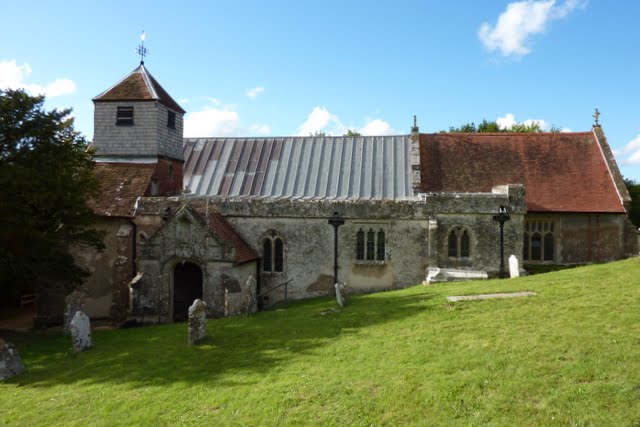 Rockbourne Church
....Richard Cromlum came to Rockborn the seventeenth of March 1619” The construction of the belfry tower was already underway when Richard arrived but was not completed until after he had left the parish. Although cast by John Wallis of Salisbury in 1617, the two bells were not hung until 1630. An inscription "1630 RC 1630" is recorded on a beam just below the eaves (not visible externally) on the south side of the tower. It has been suggested that the "RC" is Richard Crumlum who may have assisted with funding. He is listed on a modern stone plaque of past clergy in the porch. 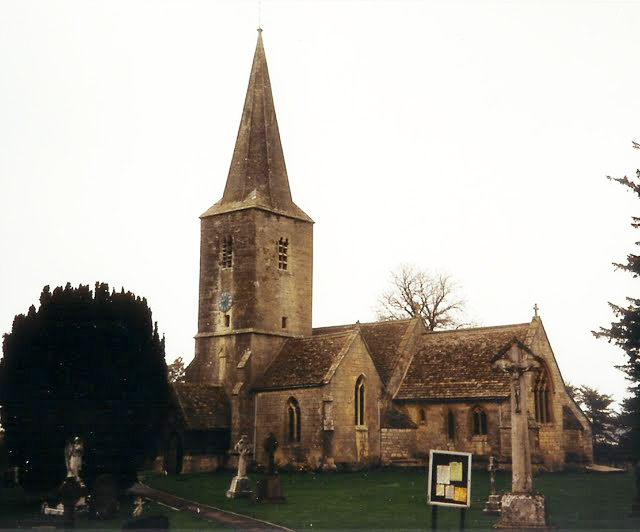 St James Church Quedegeley
………”Richard Cromlum came to Quedgeley the 4th July in anno ab. In carnatione supradicto. Anno Regni Jacobi 22” (1624). He appears to have stayed here for the rest of his life. The date and location of Richard's first marriage to Samuel's mother Elizabeth (nee ??) is not known. Richard was 26 years old when his son Samuel was born in 1618 but appears to have had two elder sisters (see 1.12). A younger sister, Elizabeth was baptized in Rockbourne on 7th September 1620. Sadly Samuel's mother died a year later and was buried there in 18th September 1620. Her name is only known due to her burial record.
As the next Rector at Quedgeley is recorded in 1649, it would appear that Richard died in 1648 (7) , aged 56 years.
stepmother is not recorded in the Quedgeley parish registers where Richard’s later children were baptized (presumably by their father Richard)
Harriott : (married name Hawkins) Margarott : (married name Nithalls). Her nephew John Church, made seemingly unsuccessful court petitions against Samuel's widow and their estate (see section 13). It would seem that they were both older sisters, daughters of Elizabeth, Richard Cromleholme's first wife, as his second wife Sybill gave birth to her children on almost bi-annual basis from 1622 to 1633 ! Elizabeth : bap 7/9/1620 in Rockbourne Hampshire (her mother probably died as a result of this birth)
(may have died as an infant as next brother also named William ?) William (8) : b. 23/11/1625 bap 1/12/1625 at Quedgeley, Gloucester. Timothy (9) : bap 10/1/1627 (all below at Quedgeley) Joane : bap 16/6/1629 Mary : bap 25/8/1631 Gyles (10) : bap 15/10/1633 2) Samuel Cromleholme (1618-1672) : (recorded variously as “Crumlum” / Cromlerine / Crombleholme) (Return to Content Listing) 2.1) Birthdate :
However this could be Wilpshire in Lancashire which is a parish adjacent to Blackburn where an Elizabeth Cromleholme married Robert Chew on May 16th 1618. In February 1672, Samuel takes a kinsman Elisa Chew as a pupil in his school and asked “to remember his love to the boy’s mother” (11). See further details under 1672 below. 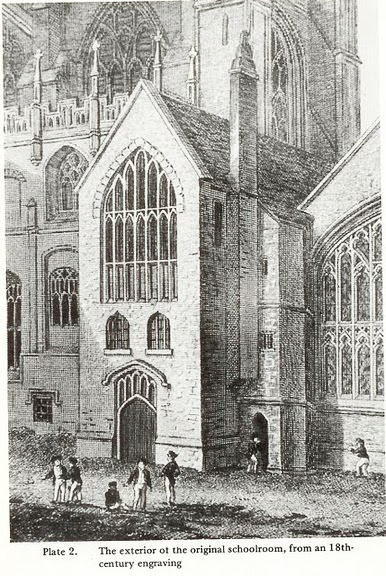 The Kings School Gloucester
He was appointed when only 19 years old by William Laud (Dean of Gloucester Cathedral) as headmaster of the College School at Gloucester on 9th March 1617. The school was later called the King's School after its founder Henry VIII. He resigned from his post in 1627 when the puritan town of Dorchester in Dorset enticed him away to teach there. However, the Gloucester Corporation in regard of "his careful teaching and educating the youth of the city and the sons of divers noblemen and gentlemen to the great grace of this city" agreed to supplement his stipend if he stayed and he was re-admitted on 11th August 1628. This probably started his relationship with Dorchester, finally leading to Samuel Cromleholme's appointment at the Free School there. In 1629, the Bishop of Gloucester, Godfrey Goodman founded a library in the cathedral whereby 'every private man [who] cannot furnish himself … might be supplied out of our common storehouse'. One of the librarians was John Langley and young Samuel Cromleholme may have acquired his love of books here. Langley finally resigned in 1635, due in some part to William Laud, who had been appointed Archbishop of Canterbury in 1633. It appears that Langley held a prebend in Gloucester Cathedral but also became a tutor to Lord Middlesex's household. Lord Middlesex was a high churchmen and consulted with Laud on a number of church rituals. It is therefore rather strange that he employed Langley who was a well known puritan and enemy of Laud. However, it is thought likely that Middlesex also played a part in Langley eventually becoming High Master of St Pauls School. In the late 1630’s, Archbishop Laud had also quarrelled with the Mercers Company regarding their authority over St Pauls School in London. He supported the High Master Alexander Gill (the younger) who had been causing the Mercers many problems at the school. An attempt in 1640 to remove the conservative John Bird as master of Gloucester's Crypt school and to replace him with John Langley was also thwarted by Laud in a very terse note ...."to bring in one Langley, a man factiously sett agaynst the government of the Church of England, insomuch that at the later Metropolitan Visitation ... he publiquely in Courte before the Vicar Generall (Oliver Cromwell) obstinately refused to conforme himself to those things which were required of him according to law and forthwith deserted the school in Gloucester belonginge to the Dean and Chapter However, Archbishop Laud was arrested in December 1640 for treason and several other charges. Shortly afterwards in 1641, Gill finally resigned from St Paul's School with the Mercers removing his pension two years later due to him libelling one of their members. On 7th January 1641, John Langley was appointed High Master of St Pauls School, London. As a result of his educational achievements, on 20th June 1643, he was appointed, by parliamentary order, as one of the licensers of the press (public censor) for books of “philosophy, history, poetry, morality, and arts”. However, he was petitioned on 20th December 1648 by the stationers and printers of London for “latterly being remiss in these duties”. During Archbishop Laud's trial for treason, on 6th June 1644, John Langley was a witness before the Lord’s committees considering one charge concerning Laud’s conduct of cathedral services at Gloucester. Laud was ultimately found guilty and executed in 1645. Langley was asked to preach a sermon before the House of Commons on Christmas Day 1644, the House formally thanking him and asking him to have it printed. John Langley was a talented school master who had “a very awful presence and speech, that struck a mighty respect and fear in his scholars which however wore off after they were a little used to him.” He had been influential in securing Samuel Cromleholme as master of the Mercers Chapel School in 1644, as his own surmaster at St Pauls School in 1647, as Master of the Free School in Dorchester in 1651 and finally as his successor at St Pauls School in 1657. During an illness before he died, he had wished to be buried at the school door as a sign of his care for its wellbeing. He died at his house in St. Paul's Churchyard on 13 Sept. 1657 and was buried on 21st September in the Mercers' Chapel. The scholars of the school attended his funeral, walking with white gloves on before the corps (hung with Verses instead of Eschotcheons) from the School through Cheapside to the chapel. A funeral sermon, subsequently printed ' (on Acts vii. 22), touching the ' Use of Human Learning,' was preached by his friend Dr. Edward Reynolds, Dean of Christ Church, and afterwards Bishop of Norwich. The preacher warmly eulogised Langley's learning and character, and stated that he was so much honoured by the governors that they accepted his recommendation of Samuel Cromleholme as his successor at St. Paul's. He also said of Langley : ....."learned in the whole body of learning; not only an excellent linguist and grammarian, historian, cosmographer, artist and a most judicious divine and a great antiquary" John Langley was held in high regard by Selden and other contemporaries, Fuller referred to him as an able and religious schoolmaster. He also published several learned books. Unlike some previous High Masters, Langley was not in debt with the Mercers Company, indeed, he even left bequests to them to buy plate and memorial rings. In his will dated 9 September 1657 (proved on 29 Sept.1658) he had left monies to and mentioned Master Cromlum of Dorchester. Langley had never married but it appears that he had taken Samuel Cromleholme under his wing not only giving him a good education but also acting as his mentor for most of his career. 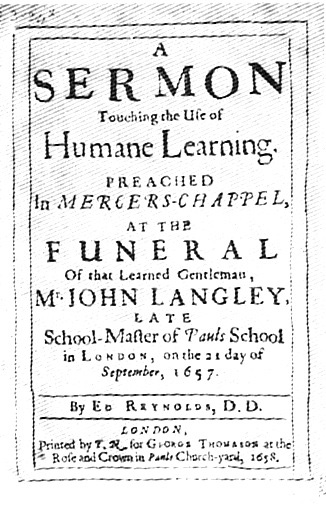
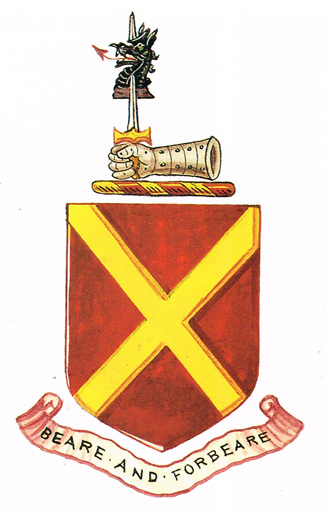
2.5) University: 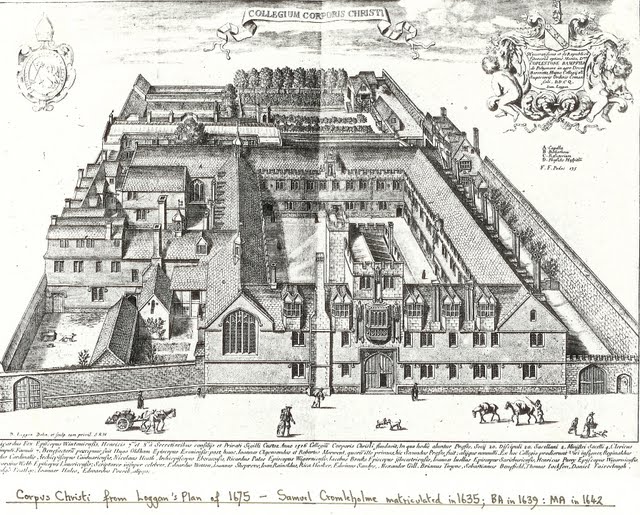 Corpus Christi College Oxford
If so, he would have taught Samuel Pepys (1633 – 1703) who he definitely taught later as surmaster at St Pauls School in London (see below). Pepys was sent to St Pauls School in 1646 aged 13.
of London) on 21st March 1644. John Langley as Highmaster of nearby St Pauls School had influence on this appointment. (aged 26)
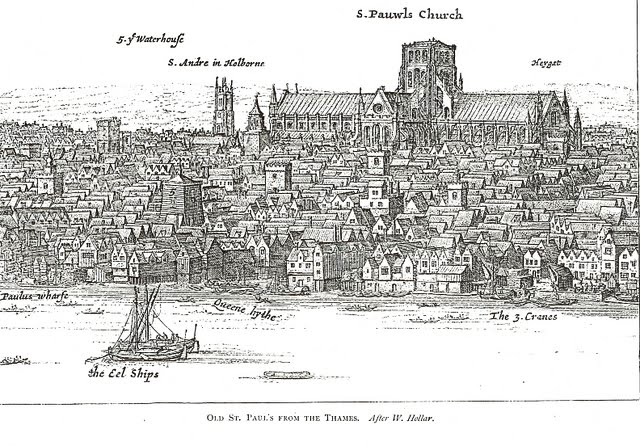
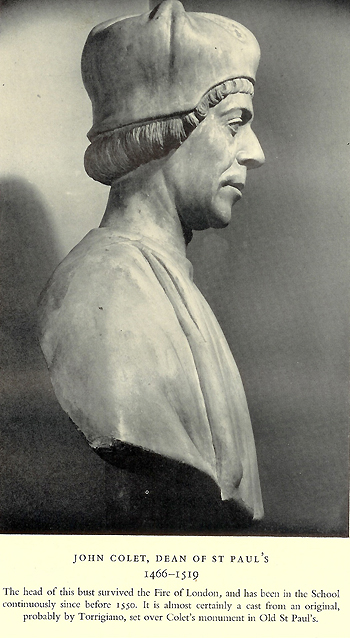
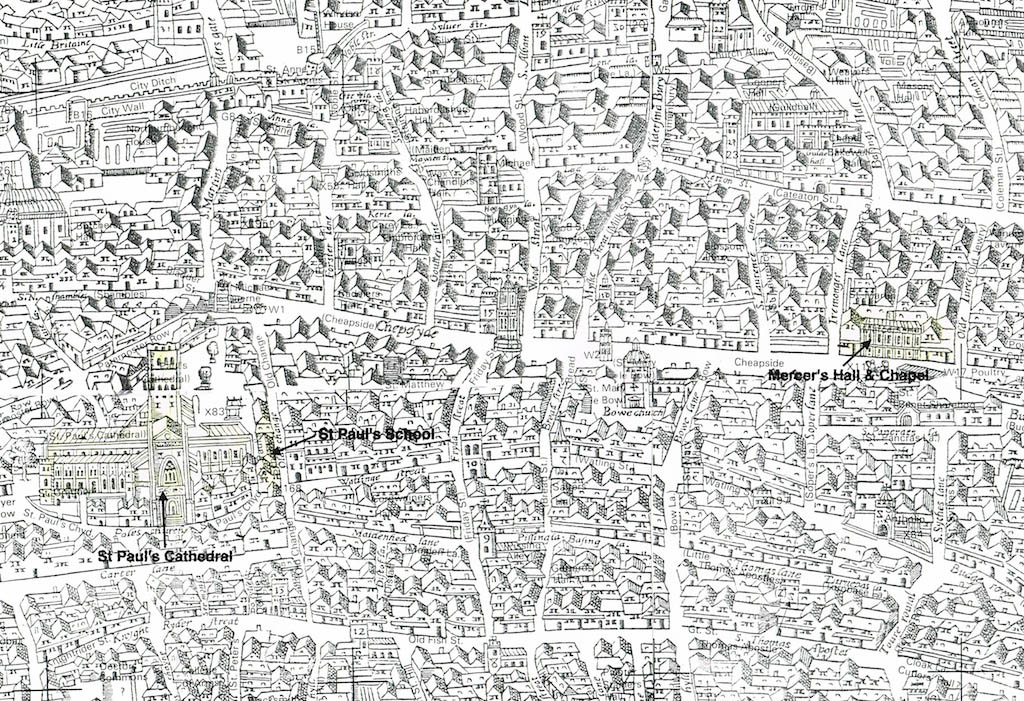
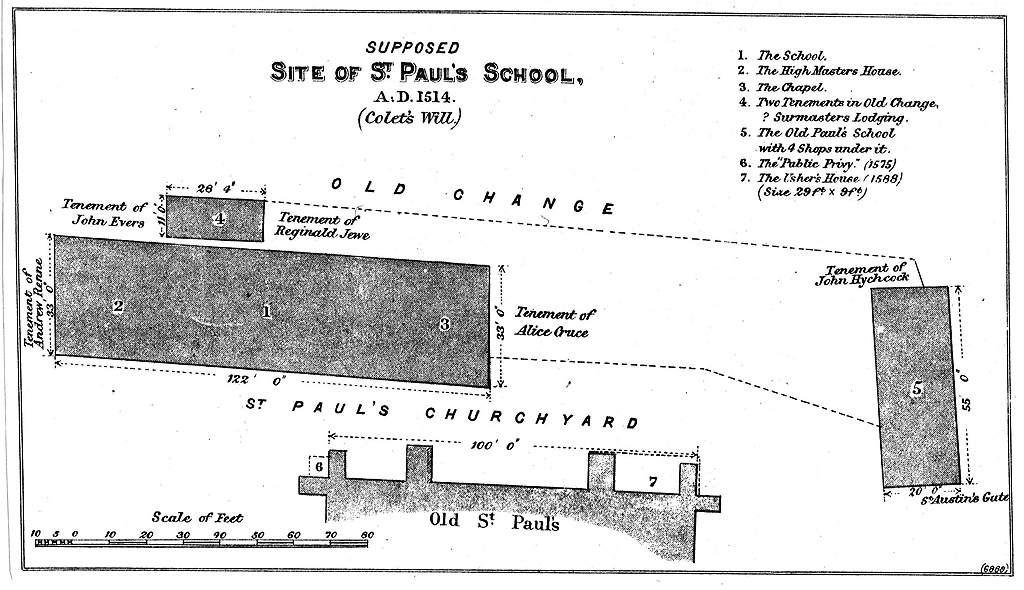 Plan of the first school (by unknown author based on John Colet's will of 1514)
The High Master appears to have had the use of a rather grand house in Stepney, then a village in the countryside outside the city. It was one of several properties that John Colet had left in trust for the school. It had been extensively repaired and rebuilt between 1648 and 1652 but there is no record of John Langley or Samuel Cromleholme actually staying there. The location of the house is not known. In 1528, the house had been used to teach 17 boys during an outbreak of the plague. They had travelled daily from the city and following this precedent, it was resolved that if it was not in use by the High Master, the house should be kept "for teaching the children when the school cannot meet in St Paul's churchyard because of the plague". It is not known why it was not used during the Great Plague of 1665 and after the Great Fire of 1666. 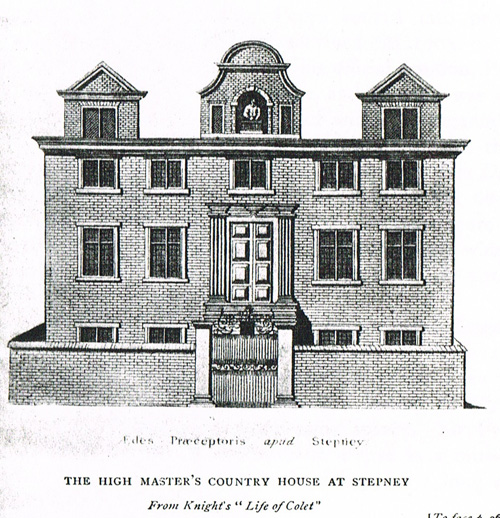
“10th October - Mr Samuel Cromleholme elected schoolmaster, from Michaelmas last.”
“in regard to the great charge he hath bin at in removing his family out of the country”.
Source : A Dictionary of the Bible: Dealing with Its Language, Literature, and Contents, including the Biblical Theology. By James Hastings & John Selbie pub 1904
Sir Richard Wood’s scholarship was founded at St John’s College, Cambridge
"Licensed to teach privately and publicly in any place within the province of Canterbury" William Juxon, Canterbury (source CCEd Record ID 306784)
of graine”
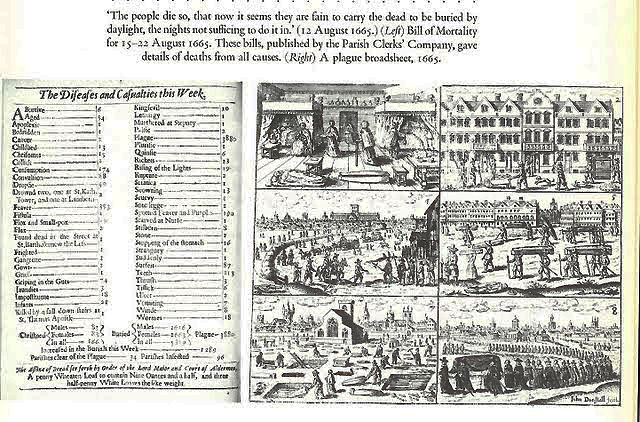 Plague of London 1665

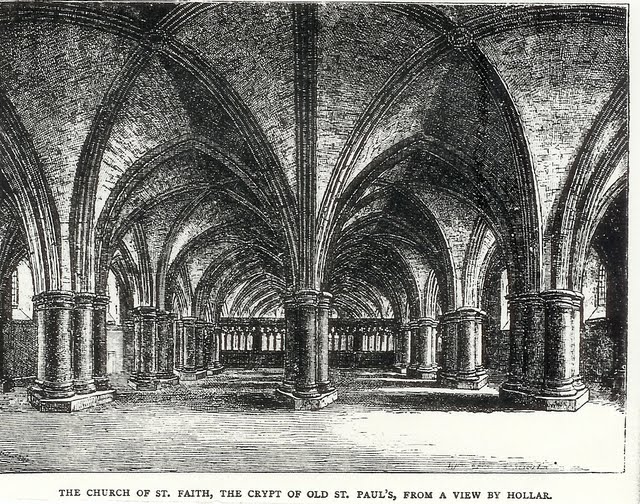
Pepys also records that Robert Scott, one of London’s largest booksellers ran an international operation with “warehouses in London, Frankfort, Paris and other places and dealt by factors”. It is probable that Samuel Cromleholme also had many dealings with such booksellers and presumably was able to procure books etc via such international factors. From his probate inventory taken in 1673, it is evident that even after having lost his library in the Great Fire, he had been spending considerable sums on books : Item - a study of books priced by Mr Kotley, a bookseller worth £100 - 00 - 00
" Wandfworth, December ye 26 1666 Worthy Sir, I thank you for your compassion, which I am sure is not ill placed as to my own particular, whatever the public detriment (as you call it) may be, by this suspicion of him, who has painfully, and (I thank God) I hope not wholly unsuccessfully served in his calling. And yet this adds to my private calamity also. I very much commend your address to the Rightworthy and Reverend Mr Dean of St Paul's. All the world of learned men are sufficiently assured that no person is more able to judge of fitness for ye University than himself. But I apprehend Mr Dean would hereby evidence that his nomination or presentation to a preferment should be warranted by something more than that of ability. Which is the best commendation of all. In every deed I have had so good proof of ye youth's both parts, industry and affection to learning that (considering the great interruption of his studies in our court of discipline) I shall not receive any prejudice, if I tell you , that I judge it now more moot to dispose of him to the University as soon as may be with safety than to stay longer, so that I have good hopes he will not prove undeserving of Mr Dean's charity, or my expectations. Sir I pray you to keep this letter, yet it may reproach the lad if he should come short. I hope to be in town shortly, and if I come, you may hear of me at Mr William Willis's in Little Britain. My due respects to good Mrs Spinedge with my wife's, to whom with yourself and Anthony I heartily with all comforts, encouragements and happiness in the quality of Sir Your friend ? & ...servant ? Sam: Cromleholme." Outer part of letter (ie it would appear to have been folded instead of being put in an envelope). It was presumably hand delivered. "To my worthy good friend Mr Thos : Bradshaw ?.....nigh Aldgate at his mother's house in London" Little Britain was an area in the centre of the City of London with Christ Church School and St. Bartholomew's Hospital to the west and Smithfield and Long Lane to the north. The part extract of the letter below gives us Samuel's handwriting, his signature and the fact that he spelt his surname "Cromleholme" 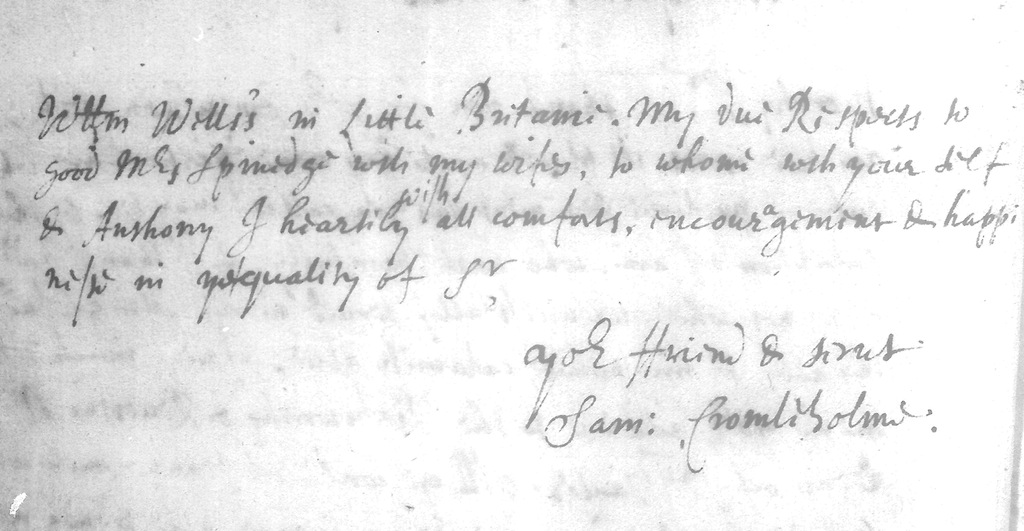
The author promotes his book ……."So enlightned, that besides the easie understanding of all Classical Authors, there is also laid open A ready way to write and speak Latine well and elegantly. Being very useful for Gentlemen, Lawyers, and young Clerks, and all others: either for Englishmen that desire to better their Knowledge in the Latine Tongue, or for Strangers to learn or speak English” The author also mentions his patrons to further promote his work ….."From the British are to name Edm. Castell, famous orientalist, a principal associate at the Biblia Polyglotta by Walton, Sam. Cromleholme, Head Master of St. Paul's school, the lexicographer Adam Littleton, the astronomer John Goad, the mathematician Thomas Branker, etc All of them, authorities in the areas of a subject, speak of the works Jász Berényi with the warmest appreciation and hope that it may be found in the English school the greatest proliferation.”
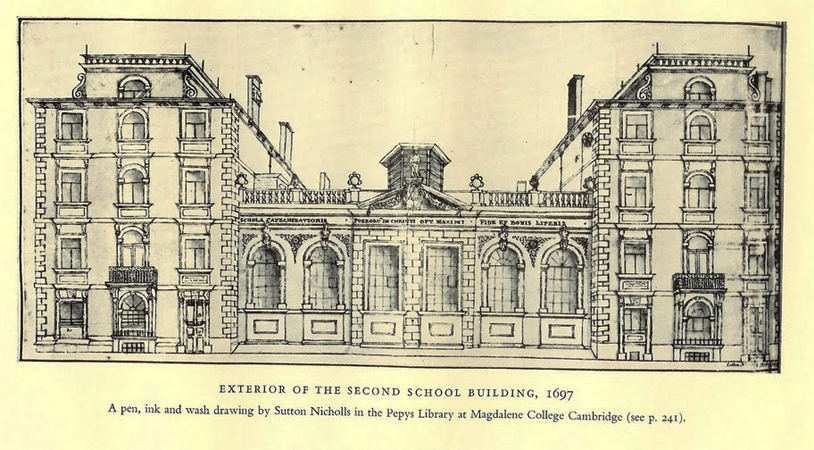 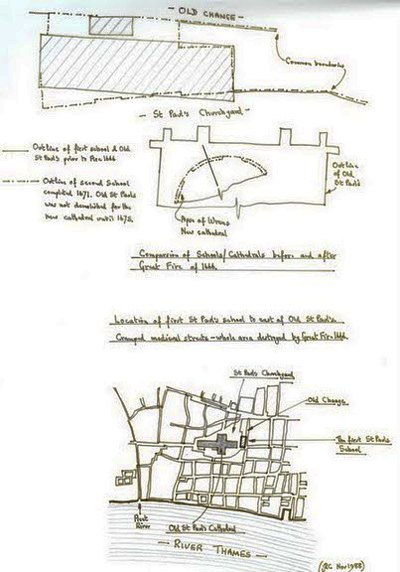
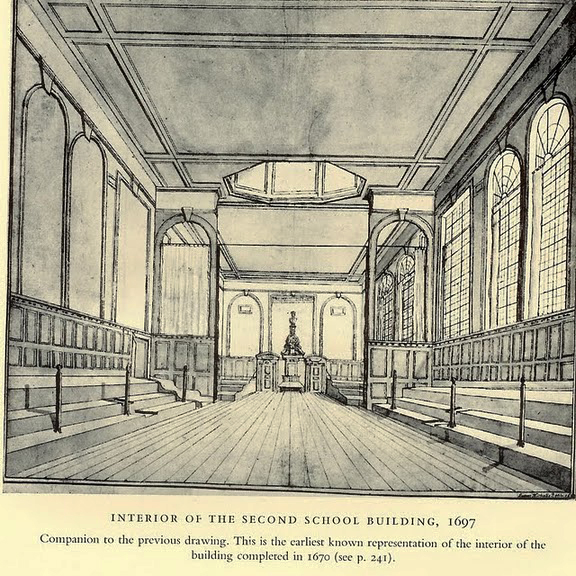
At the upper end of the School, facing to the Door, was a decent Cathedra, or Chair placed, somewhat advanced, for the high Master to sit in, when he pleased, and to teach and dictate there. And over it was a lively Effigies, (and of exquisite Art) of the Head of Dr. Colet (see 2.9) , cut (as it seemed) either in Stone or Wood with the inscription, " Intendas animum studiis et rebus honestis." (fix the mind on virtuous studies and matters) He also notes the " large and elegant apartments " of the high master, and the rather stern inscription above the school room doorway “Doce Disce aut Discede " (Prove that you can learn or leave) He also notes that underneath this ....since the rebuilding of the school by the Mercers, for ever grateful Remembrance, were these Lines added, composed, I conjecture, by Mr Crumleholm, then the worthy Master : "Ad seræ Posteritatis imitationem, æternitatem Famæ suæ; Post luctuosam Urbis Londinensis deflagrationem M Dc Lxvi, amplissima MERCERORUM Societas Fidem Fundatori MAKAPITHTO, datam sanctissimè per solvens, Scholam hanc de integro extruendam instaurandamque, curavit: Perfecitq; Dno. RICHARDO FORD Equite, Urbis Præfecto, Custode vero, totiusq; Negotii assiduo diligentissimoq; Procuratore, Dno. ROBERT WARE. Dignos laude Viros Musa vetat mori".
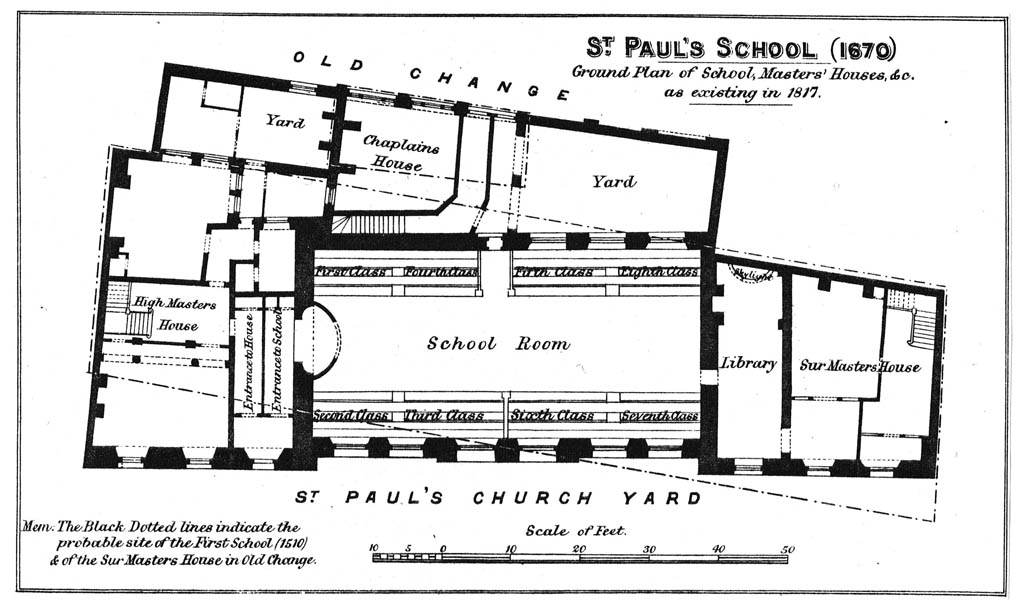 Plan of the second school designed by Edward Jarman
I hope this will have ye good fortune ....(tear in paper) ... safe to your hands though my last to you did miscarry yours in behalfe of little Chew. I received (?) and was in expectation of him every day since ye receipt of it and so much ye more in regard I had ...... yet one of Mr Crumleholme's name was comeing up to him therefore we might not be disappointed I went beforehand to Mr Crumleholme to find how ye matter was and upon enquiry he freely let me yet he had notice of such a one; but yet he was fixed and resolved for his little kinsman who since has arrived and was entertained by ye old man with us much kindness and ....... as if he had beene his owne child but ye particulars I leave to Will Clayton to relate to you who was present when I presented him to Mr Crumleholme; I'm sure ye boy cannot miscarry if he is not wanting to himselfe and so much for this affayre. .............. I am your affectionate J Franckland Source Lancashire Record Office (Kenyon of Peel papers ref DDKE/9/43/19) (from Judges Lodgings Museum of Lancaster) 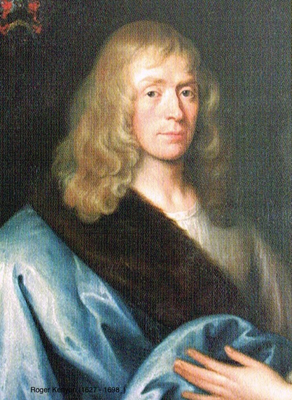
Further information is given after Samuel's death by his widow Mary Cromleholme in his probate documents which records her spending £15 to fulfil Samuel's wish to "plan him (Elisha) out in the world".
3) Famous Pupils: (Return to Content Listing) There are four entries recorded in the Admission Registers of the College which is a remarkable number from a school of its size: 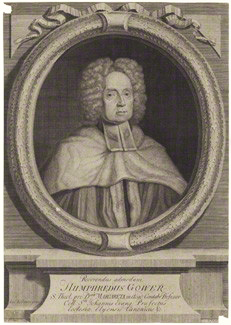
John Churchill, Duke of Marlborough : 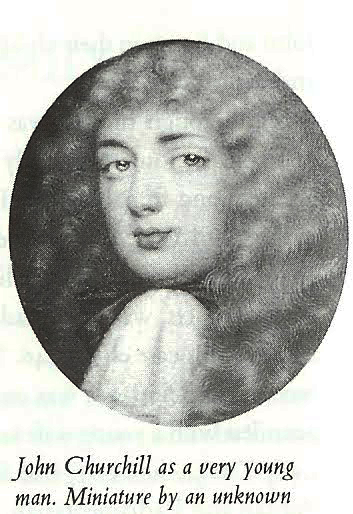
Sir Winston Churchill (20th century) quotes a letter of his widow, Sarah, Duchess of Marlborough (in 1774) in which she speaks of the Duke as having been "whipt at St Pauls School for not reading his Book" Whether or not Samuel Cromleholme had carried out this punishment is not known! ……."There is also a tradition in the school that during his time there, he showed leanings to his future career by reading and re-reading the four volumes of the classic Roman military guide “De re inilitari.” (concerning military matters) written by the 4th century Roman Publius Flavius Vegetius.” 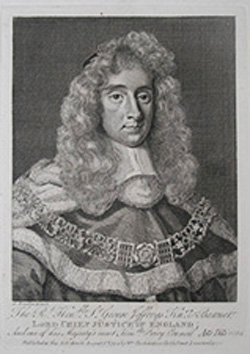
Link to postcard showing Judge Jeffreys Lodgings in Dorchester circa 1894-1910 Link to the Life of Judge Jeffries 1st Baron Jeffreys of Wem
John Fuller : Son of Thomas Fuller the author of "The Worthies". Samuel Bradford : Bishop first of Carlisle and then of Rochester, and Dean of Westminster. George Doddington : Lord of the Admiralty, patron of letters, and builder of Eastbury at Tarrant Gunville in Dorset. Elihu Yale :
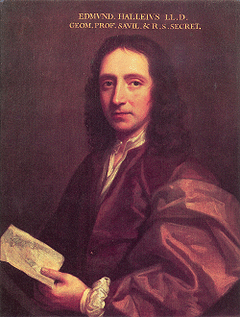
... equally distinguished in classics and mathematics,rose to be captain of the school at fifteen, constructed dials, observed the change in the variation of the compass, and studied the heavens so closely that it was remarked by Moxon the globe maker 'that if a star were displaced in the globe he would presently find it out'.
4) Samuel’s Staff at St Pauls School : (Return to Content Listing)
5) Pepys Diary : (Return to Content Listing) It seems that pupils at St Paul's School were encouraged to keep a diary and this may have been one reason that Pepys started his in 1660. Pepys had decided to keep his diary secret and record intimate experiences as well as everyday events at home and work. He also liked to record his increasing wealth starting with mere £25 in 1660 and being worth some £10,000 a decade later when the Diary ends. 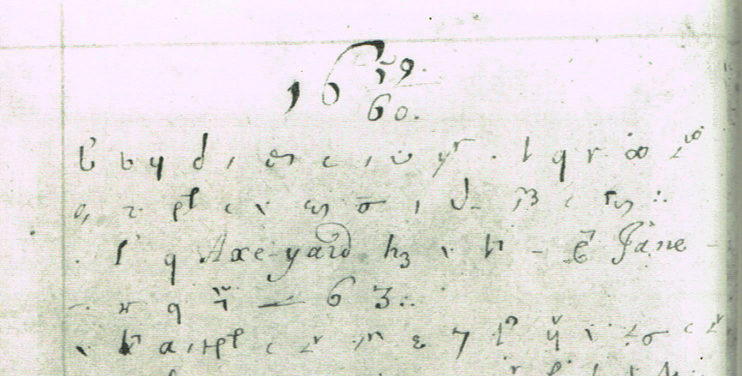 It is dated 1659/60 as the year did not begin until 25th March (Lady Day). It is clearly written with letters neatly spaced using both shorthand and longhand.
24th January 1660 ……"After this, taking leave, I went to my father's; and my wife staying there, he & I to speak with Mr Crumlum (in the meantime, while it was 5 o'clock, he being in the school, we went to my cosen Tom Pepys' shop, the-turner in Paul's Churchyard, and drank with him a pot of ale: Mr Crumlum gave my father directions what to do about getting my brother (John) an Exhibition, and spoke very well of my brother." 7th February 1660 : "………then went to Paul's School; but it being too soon, I went & drank my morning draught with my cosen Tom Pepys the turner and saw his house and shop. Thence to school, where he that made the speech for the Seventh Form, in praise of the Founder, did show me a book* which Mr Crumlum had lately got, which is believed to be of the Founder's own writing. After all the speeches in which my brother John came off as well as any of the rest I went straight home and dined.. " (* the book mentioned cannot be identified and therefore is thought to have perished in the fire) 23rd December 1660 : ….."I took coach and lighting at my booksellers in St Paul's Churchyard I met there with Mr Crumlum, and the second master of Paul's School, and thence I took them to the Starr, and there we sat and talked, and I had great pleasure in their company, and very glad I was of meeting him so accidentally, I having omitted too long to go to see him. Here in discourse I did offer to give the schoole what book he would choose of £5. So we parted and I home." 27th December 1660 : …”In the morning to my booksellers to bespeak a Stephen's Thesaurus for which I offer 4£, to give to Paul's Schoole. And thence to Pauls church & there I heard Dr Gunning preach. Here I met with Mr Crumlum and told him of my endeavours to get Stephen's Thesaurus for the school." 21st July 1662 : ….."Here I drink wine and eat some fruit off the trees and he (Capt Cockes) showed me a great rarity which was two or three of a great number of Silver dishes and plates which he brought of an Embassador that did lack in money. In the edfe or rim of which was placed silver and gold medals, very ancient and I believe writ, which if they be, they are the greatest rarities that ever I saw in my life - & I will show Mr Crumlum them."
17th September 1662: ………………………"After dinner Mr Moore and I about three 0' clock to Pauls school to wait upon Mr Crumlum (Mr Moore having a hopeful lad, a kinsman of his, there at school); who we take very luckily and went up to his chamber with him, where there was also an old fellow student of Mr Crumlum's one Mr Newell come to see him, of whom he made so much, and of me, that the truth is, he with kindness did drink more than I believe he used to do, and did begin to be a little impertinent - the more when, after all, he would in the evening go forth with us, and give us a bottle of wine abroad. And at the taverne met an acquaintance of his that did occasion impertinent discourse, that though I honour the man and he doth declare abundance of learning and worth, yet I confess my opinion is much lessened of him. And therefore let it be a caution to myself not to love drink, since it hath such it has an such an affect upon others of greater worth in my own esteem. I could not avoid drinking five glasses this afternoon with him. And after I had parted with him (& following another drinking bout with other friends in the evening I!)……."and so Mr Moore and I to bed and neither of us well pleased with our afternoon's work, merely from our being witnesses to Mr Crumlum's weakness."
4th February 1663 : “Up earely and to Mr Moore, and thence to Mr Lovell about my law business, and from him to Pauls Schoole, it being opposicion Day there. I heard some of their speeches, and they were just as schoolboys used to be, of the seven Liberall Sciences; but I think not so good as ours were in our time. Away thence and to Bow Church and back again to Pauls schoole and went to see the head forms posed in Latin, Greek and Hebrew, but I think they do not answer in any so well as we did; only in Geography they did pretty well. Dr Wilkins and Outram* were examiners. So down to the school, where Mr Crumlum did me much honour by telling many what a present I had made to the school, showing my Stephanus in four volumes, cost me 4£ 10s. He also showed us upon my deseire an old edicion of the grammmer of Colletts - where his epistle to the children is very pretty. And in rehearsing the creed it is said "borne of the cleane Virgin Mary." 11th May 1663 : .................. I called upon Mr Crumlum, and did give him the 10s. remaining not laid out of the £5 I promised him for the school, with which he will buy strings, and golden letters upon the books I did give them. I sat with him and his wife a great while talking; and she is [a] pretty woman, never with child, and methinks looks as if her mouth watered now and then upon some of her boys" 4th February 1664 : ….Up and to the office, where after a while setting, I left the board upon pretence of serious business and by coach to Pauls schoole, where I heard some good speeches of the boys that were to be elected this year. Thence by and by with Mr Pullen and Banes with several other of my oId acquaintance to the Nags Head tavern and there did give them a bottle of sack; and away again and I to the school and up to hear the upper form examined; and there was kept by very many of the Mercers, Clutterbucke, Barker, Harrington, and others, and with great respect used by them all and had a noble dinner. ……………..Here they tell me that in Dr Colett's Will he says that he would have a master found for the school that hath good skill in Latin and (if it could be) one that had some knowledge of the Greeke; so little was Greek known here at that time. Dr Wilkins and one Mr Smallwood, posers. After great pleasure there, and especially to [hear] Mr Crumlum so often to tell of my being a benefactor to the school - I to my booksellers" (a little flattery obviously worked wonders on Samuel Pepys!!) 10th August 1664: Pepys visits Edward Cocker (usher of Pauls School) the famous writing master to get him to “engrave tables upon my new sliding rule" 9th March 1665 :............. "and set down at Paules schoole, where I visited Mr Crumlum at his house. And Lord! to see how ridiculous a conceited pedagogue he is, though a learned man, he being so dogmaticall in all he doth and says. But among other discourse, we fall to the old discourse of Pauls Schoole; and he did, upon my declaring my value of it, give me one of Lillys grammer of a very old impression, as it was in the Catholique times; ("In usum, antiquae et celebris scholae") which I shall much set by. And so after some small discourse, away……. "
26th September 1666 : ...... "But here by Mr Dugdale (bookseller) I hear the great loss of books in st Pauls churchyard, and their hall also – which they value at about 150000£; some booksellers being wholly undone; and among others, they say, my poor Kirton (one of his booksellers). And Mr Crumlum, all his books and household stuff burned; they trusting to St Fayths (33) , and the roof of the church falling, broke the arch down into the lower church and so all the goods burned - a very great loss."
6) Portrait by Mary Beale : (Return to Content Listing) 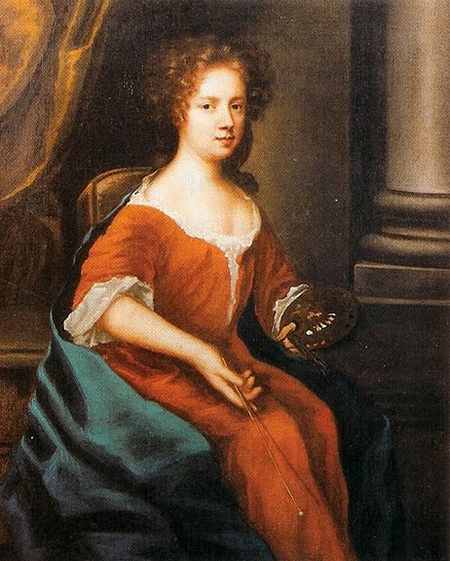 Mary Beale
Dr Stillingfleet Mr Crumholmes pictures 25”. – 0 – 0.
Dr Cradocks Dr Tillotson Aug : Dr Stillingfleet Mr Cromholmes
7) Samuel’s Marriage and Wife : (Return to Content Listing)
8) Samuel’s Wife’s Family : The Bury Family of Dorchester. (Return to Content Listing)
Sarah Bury b 1622 Phineas Bury b 1634 Mary Bury b 1624 (39) John Bury b 1636 Elizabeth Bury b 1626 Thomas Bury b 1638 1622 Richard Bury recorded as a capital Burgess 1627 Constables Richard Bury & Richard Williams both men of puritan sympathies. 1640 Richard Bury elected feoffee of Dorchester Free School 24 Mar 1640/1. Also Mayor of Dorchester 1640/1 1644 As the county treasurer Richard Bury, was one of the few who did well out of the war, but he had unusual opportunities. 1647 Dennis Bond MP for Dorchester subscribed 2000 pounds for the Irish adventure at the request and in trust for assigned land in Ireland. Between 1655 and 1659, Richard Bury and John Whiteway were assigned land in the Barony of Kenry, Co. Limerick in the NE and SE quarters. (41) 1649 White’s successor, Stanley Gower arrived in Dorchester shortly after the king’s execution but he loathed the radicals who had thrown his world into chaos. When asked to take a new loyalty oath in 1649, Richard Bury & John Bushrod subscribed “in this sense only, that I will live peaceably under this present power and obey them in lawful things”. 1650/1 Elected mayor of Dorchester once more. Samuel Cromleholme becomes Head master of the Free School. 1653 In April 1653, Cromwell became Lord Protector and the corporation was under pressure to get rid of possible dissidents in 1654. Philip Stansby (a grocer who had been Richard Bury’s apprentice) replaced Gould. Later local gentry were rounded up and Sir John Strangeways was jailed for a short time. 1659 After Cromwell’s death in January 1659, the corporation felt vulnerable – Bury & Savage were both well into their seventies.For a brief moment, Dorchester had something like a municipal health service. Doctors and apothecaries received money for treating the poor. Richard Bury and a new apothecary Richard Atkins provided medicines. 1661 Richard Bury died between 1st April & 1st October in London (probably living with his son-in-law Samuel C & his daughter Mary). Link to transcription of his will (42) which was proved 25 Oct 1661. He nominates Samuel Cromleholme along with his three other son-in-laws as overseers of his will together with a gift of 40s each to buy rings in remembrance of him. There is a large schedule of debts "to be paid by my trustees" amounting to nearly £3000. Amongst these is "To Samuel Cromleholme by Christ £200". This debt appears to have remained unpaid even at his daughter Mary Cromleholme's death in 1692. 1664 Richard Bury’s sons Phineas (Rector of Southrop, Gloucestershire) and John were assigned land in Ireland in 1664. John Bury married Ann Bascombe and their son Richard Cromleholme Bury was born 24th October 1664 and baptised 8th November in St Peter’s Church Dorchester. He married Esther (d/o David Sollom) in Dublin on 23rd February 1687. Their daughter Mary married Samuel Clutterbuck (43) . Richard Cromleholme Bury died young aged 27 on 23rd November 1691. 1681 A manuscript (44) (dated as begun in 19 October 1681) was written by Richard Cromleholme Bury, “whose identity is not known. He had probably drawn on both Walker and Holdsworth as perhaps indicated by the reference to his sources at the end of the entry: ‘per W. H’ “. This appears to concern methods of note taking and perhaps diary writing – possibly influenced by Samuel Cromleholme originally. Interesting to note that Cromleholme was taken as a second name or possibly a lengthened surname. More research is required into the Bury Family – especially the Ireland matters 9) Children : (Return to Content Listing)No children of Samuel & Mary Cromleholme have been located and all records note this fact as well. 10) Samuel’s Death and Funeral: (Return to Content Listing) Samuel died Sunday 21st July 1672 aged 54 years. The Register of St Mary Colechurch records his burial in the Mercers Chapel (45) on Friday 26th July 1672. His funeral service was held in the Guildhall Chapel (46) with his friend Dr John Wells (47) preaching his funeral sermon. Posie Rings were distributed engraved “Redime Tempus”(= Seize the flying hour) (48) .
Source Footnote : A history of St. Pauls School by Michael F. J. McDonnell p238 (original source being Camden Society, 1849) Samuel's Probate documents (see section 12 below) add some interesting detail to the arrangements and illustrate the considerable costs of his funeral. The first item relates to the posie rings noted above and it appears that a considerable number were made. Given the number, it is possible that some still survive today ?
Paid for use of the Pall to bear & move the coffin often refers to a cloth draped over the coffin = 15s :0d Paid to the clerks of the Chapel of Guildhall... for attendance & fees = £10 Paid to the officers of the Mercers Company who attended = £20 Paid to one Master William Antloby a draper for black cloth for mourning = £15 Paid to Mistress Dorothy Harvis & Master Hunsham for mourning hoods, scarves and ribbons and for mourning gloves given at the funeral = £13 : 17s : 0d Payments were made to various members of both their families for mourning and Samuel's household servants are also mentioned :
Paid to Ann Road the maid servant of the deceased for mourning = £3 Paid for mourning for Mary Road (presumably a sister of Ann above ?) the deceased servant who had been very favourable to him in his lifetime. = £5 Other items recorded :
Paid to Doctor Wells for the funerall sermon..... = £3 : 3s : 6d Paid to one master Turner for a coffin..... = £3 The cost of the duties (dues) for the burial in the Mercers Chapel were remitted to his widow Mary Cromleholme on the 5th August 1672 in a resolution agreed by the Mercers Court of Assistants. One other interesting payment is :
11) Samuel's Burial in the Mercer's Chapel: (Return to Content Listing) The Register of St Mary Colechurch records Samuel's burial in the Mercers Chapel on Friday 26th July 1672. (see map in section 2.9 for location of the Mercers Hall and Chapel). 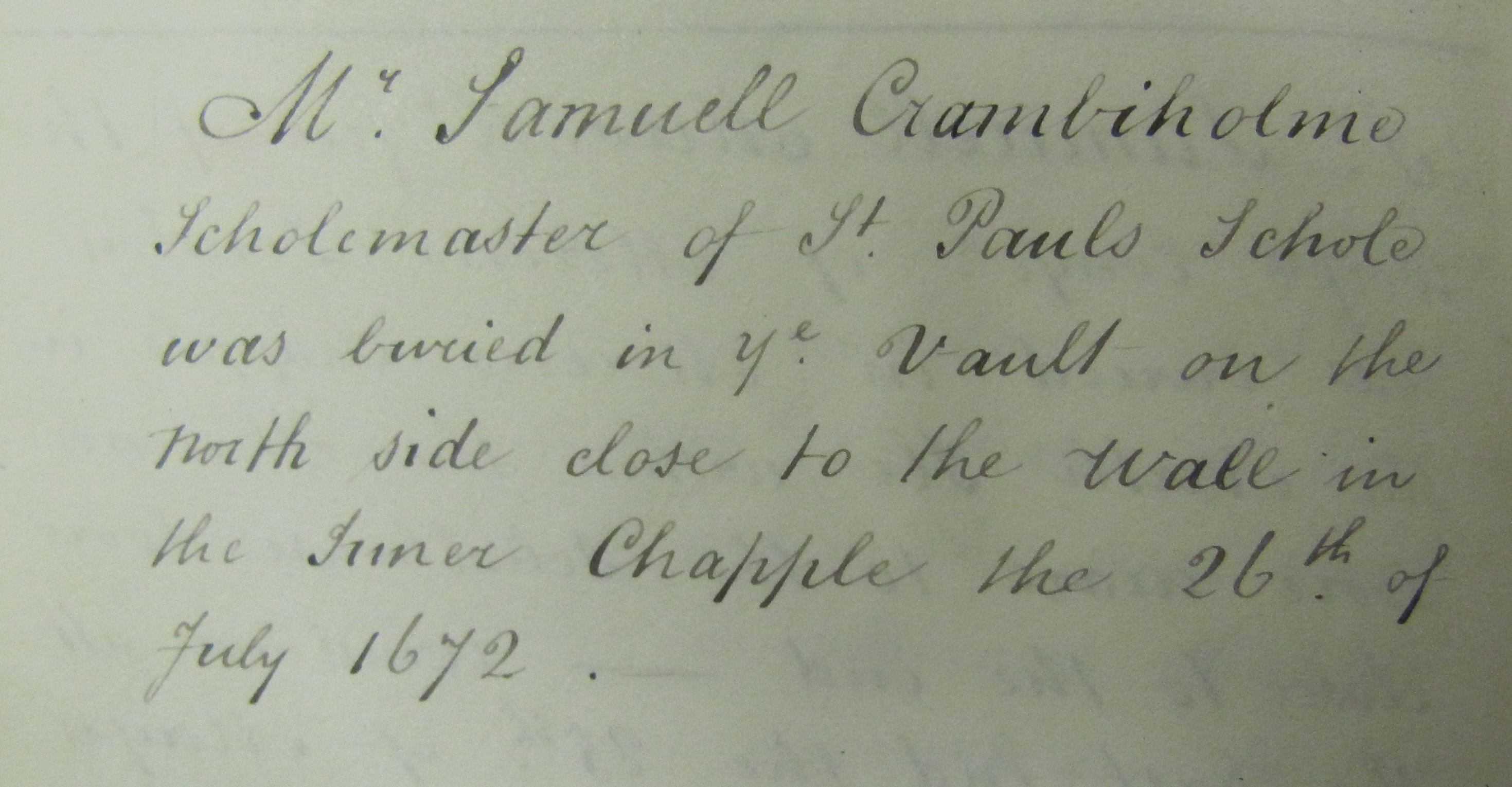 The Merecers are the only City Livery Company to have their own chapel. The first chapel with its font elevation on Cheapside was built between 1517 and 1524 with a Hall above it. In 1538, after the dissolution of the adjoining Hospital of St Thomas of Acon (originally a C13th monastery), the Mercers acquired the whole site but on the condition that the chapel was maintained. John Langley had been buried in this first Chapel earlier in 1657. The Great Fire of 1666 destroyed the Hall and Chapel to such an extent that it had to be completely rebuilt. In 1667, the Mercers Court had approved a preliminary scheme drawn up by their architect Edward Jarman for a new Hall and Chapel behind a detached row of shops in Cheapside. Edward Jarman is also thought to have designed the new St Pauls' School. Although work started on the shops, it was not until October 1668 that the foundations of the Hall & Chapel were started. Edward Jarman unfortunately died and the detailed drawings were made by the architect John Oliver in November 1669. The Chapel Porch was built first and then the Chapel itself which was completed in 1672. The Hall and Ambulatory and the rest of the building above were not completed until 1676. The first court in the new Hall was held on 4th May on that year. 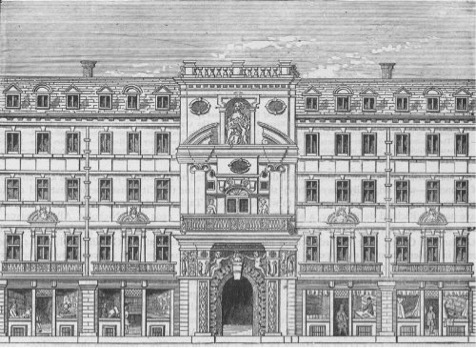 The Mercers Hall rebuilt after the Great Fire (from an old wood cut print c1880 - Mercers Company) The building was restored in the latter part of the C19th and again in the late 1920’s. Late in 1940 during WW2, it suffered some minor bomb damage but during a very heavy bombing raid on the night 10/11 May 1941, it was completely destroyed. Fortunately no one was injured or killed and the Mercers had had the foresight to remove their valuable items of furniture, artwork and archives in 1939. Work on the present (third) Hall started in 1953 and during foundation works a late medieval statue of Christ was discovered buried under the Chapel. This very high quality stone statue dates from c1500 and appears to have been buried to prevent it being destroyed during the Reformation. The present Hall has approximately the same arrangement and layout as the second one except that the ceremonial entrance and main staircase was resited from Cheapside to Ironmonger Lane. During the rebuilding, the vaults were filled in and all burials exhumed under Home Office Supervision and reburied at the Brookwood Cemetery near Woking in Surrey. Samuel Cromleholme would thus have been one of the first people to be interred in the vaults of the newly built Mercers Chapel in 1672. Whether an inscription existed marking his resting place is not known. This is not mentioned by any of the St Pauls School historians accounts written before WW2. John Langley had been buried in the first Chapel in 1657 and it is not known if his remains were re-interred in the second Chapel. By a quirk of fate, after some 269 years Samuel's remains were rather violently disturbed and some ten years later moved to their present site in Brookwood. Enquiries made to Brookwood Cemetery and the Home Office have yet to yield any further information. My thanks to the Mercers Company for their assistance. For more information about the Mercers Livery Company, Hall and Chapel please visit their website : 12) Samuel’s Will : (Return to Content Listing) Unusually for an educated person, Samuel left no will and having therefore died intestate, a Letter of Adminstration below (in Latin) was lodged (49) 31st July 1673.  Probate Documents - The National Archives at Kew hold extensive probate documents for both Samuel Cromleholme and his wife Mary. These have now been photographed and transcribed in full and can be accessed via the Crumbleholme Family History website : 13) Mary Cromleholme - His widow : (Return to Content Listing) Details of Mary's earlier life and family can be found in sections 7 & 8. At some time after her husband's death, Mary Crombleholme moved from London to Templecombe (Abbyscome) in Somerset where she died aged 68 some twenty years later in 1692. There appears to be a reference in the probate documents to Samuel and Mary owning a property here before Samuel's death (Mary's father Richard Bury owned property in nearby Buckhorn Weston, Dorset). It is possible that Samuel was planning to retire from St Paul's School perhaps when the school was established again in its new building. Genealogical Notes :- (Return to Content Listing) (1). Richard’s university records note him – “of County Lancaster”. Lancashire is where all Crombleholme / Crumbleholme / Cromleholme families appear to originate. Richard & William are common male Christian names from the earliest times. Branches of the family are recorded as clerics back to the C14th – there are potential (as yet not proven) links still being researched. Later C18th vicars also omitted the “b” from their names. “Crumlum” being the phonetic spelling. (2). Alumni Oxoienses (1500-1714) J Foster 1891 Vol 1 p354 & Brasenose College Register 1509-1909 (vol 1 p111) (3). OCRO Oxford Diocese Papers e.9 Bishop John Bridges 1604-18 Index sourced by internet - description states 104r No college, stated forename in English in signature. Actual source record not seen as yet. (4). Noted in a small booklet 'Rockbourne Clergy & Churchwardens of the 17th Century' by Andrew Winser 1979. Parish Records and Stone plaque in church porch listing all incumbents confirms this. (5). Entry in Quedgeley parish register. Quedgeley – a small parish approx 3 miles SSW of Gloucester on the banks of the River Severn and on the medieval “King’s Way” between Bristol and Gloucester. (6). Sybill Guidott was eldest daughter of William Guidott, a large landowner in the Rockbourne area. (7). Unfortunately, there is a break in the Quedgeley burial entries between 1643 & 1648 and no entry appears in 1649. (8). A court case in Gloucester in 1681/2 records – William C v John Carlles writ for debt payment (National Archives Kew) (9). Sir Thomas Davies : the first bookseller Lord Mayor of London by Charles Rivington (Bibliographical Soc 1981; s6-III: 187-201) records that the then Thomas Davies ……”was bound apprentice on 17th April 1648 through the Stationers’ Company to Thomas Whitaker, bookseller of the Kings Arms, St Paul’s Churchyard. On the same day, Timothy Cromlum apparently a younger brother of Samuel Cromleholme, was also bound to Thomas Whitaker. Davies was made free of the company in 1655”. Davies went on to eventually become Lord Mayor of London in 1676. He had been a pupil at St Paul’s school in 1647 when Samuel Cromleholme began his six year’s term as surmaster. He was elected Sheriff in 1667 and it is very likely that he was influential in securing the privilege of holding Samuel’s funeral service in the Guildhall Chapel in 1672. (10). As noted previously, Gyles is recorded as starting an apprenticeship aged 15 years in Gloucester in 1648. There is also a further (as yet undated record) from the Quarterly Courts of Essex County, Massachusetts (an English American colony) “Mr Nicolas Easton v. Giles Crumlum” (11). From a letter written by Thomas Greenfield to Roger Kenyon (Historical Manuscripts Commission 14th Report, Appendix P1 IV (1894) “Manuscripts of Lord Kenyon” Kenyon family of Peel Hall, Little Kenyon. (12). Recorded as Sam Crumlum. sacerdotis famuli (ie clerical family background). Matric Nov 13 1635 Wiltonensis, fil R.C. sacred, aet 17 (History of Corpus Christi College T Fowler (Oxford HS pp193, 454). (13). John Strype’s of London notes “Samuel Cromleholme of Corpus Christi College, Oxon, who was also removed from the government of Gloucester School hither, where he had once been second master.” No records found to substantiate this as yet. (14). Dorset NHAS Vol XLVII p134 (J M Fetcher) “A Trio of Dorset Worthies” The master Rev Henry Cooke paid £10 a year to an “usher” or under master to do the teaching whilst he lived away from the area – Samuel is not actually recorded by name. Oliver Cromwell had attended this school up to 1616. Samuel Pepys attended this school from 1640 prior to moving to St Paul’s School London in 1646. Pepys was definitely taught by Samuel Cromleholme at St Pauls where he was appointed surmaster in 1647. (15). Noted in Banbury Historical Society, Oxford Record Society (J S W Gibson) (16). Buckinghamshire record Society 1983 p59 (17). The appointment of the Surmaster was the responsibility of the Highmaster. Langley had to appoint another master at the Mercers Chapel School to facilitate this move. The title of surmaster was peculiar to St Pauls – taken from the Latin submagister. (18). Dr Stanley Gower had become rector of Holy Trinity in Dorchester in 1649 and his son Humphrey had attended St Pauls School under his old friend John Langley. He had contacted Langley on behalf of the Corporation of Dorchester for advice and after several abortive attempts to procure a master, Langley recommended Samuel Cromleholme his surmaster. Humphrey Gower had moved with his father and attended the Dorchester Free School (founded by Thomas Hardye in 1579) where he again was taught by Samuel Cromleholme. He was one of Samuel’s most distinguished pupils at Dorchester becoming Master of St John’s College Cambridge. In his will of 1708, he left an exhibition to St John’s College Cambridge for boys of both Dorchester and St Pauls School. (19). The mayor of Dorchester at this time was Richard Bury – Samuel’s future father in law – see further details below. (All extracts from the Minute Books of Dorchester). In 1657, Samuel is described as being very curious in books and later reputably had the largest private library in London. (20). Court of Assistants held at the school the day after Langley’s death …”Samuel Crumlum now Mr of the free schole at Dorchester in the west (of whom Mr Langley left a voluntary testimony of his admirable and unpareleld abilities for the management of that ymployment)” There were three candidates considered - Samuel was elected with 16 votes against 1 vote and 0 votes. He was appointed the next day on 14th September 1657 and having resigned from his post in Dorchester on 9th October assumed the office of Highmaster on 21st October when he promised due obedience to the Ordinances of the school and the Court settled him in the High Master’s seat in the school house. (21). Both extracts from Knight’s Life of Colet (John Colet being the founder of St Pauls School in 1509, the son of a very wealthy Lord Mayor, he entrusted the school to the Mercers Company in 1512) (22). “A Model for the education of Students of choice abilities at the University (Cambridge) and principally in order to the Ministry April 1st 1658” (from Quarterly Register of the American Education Society Nov 1830 p150 ….. Education society of the 17th century) (23). Source : Guildhall Library 9539/C - (Bishop Gilbert Sheldon 1660-63) “scholam coletianae juxta dvi pauli Grammatices praeceptor primaries” (24). A later entry that year in the school’s “fasti” records that he “wrote a schedule of bookes in the school study”. (25). The Great Fire started in a bakehouse in Pudding Lane about 1000 yards east of St Pauls early in the morning of Sunday 2nd September 1666. Pepys records in his diary on 7th September … “up by 5 o’clock and blessed be God ! fine and well and by water to Paules wharfe. Walked thence and saw all the town burnt. And a miserable sight of Paules Church with all the roofs falled, and the body of the quire fallen in St Faiths : Paules School also, Ludgate and Fleet Street” (26). MSS presented by Richard Rawlinson (an old Pauline) to Bodley (Pauline v.xxii n137 p5) (27). References to this temporary school in Wandsworth (south of the Thames) occur in T A Walker’s Admission to Peterhouse and Dr Venn’s Register of Caius College. The location is not been found as yet. Samuel's letter written in December 1666 from Wandsworth (Source : Bodleian Library, Oxford - Letter MS Tanner 41 42 folio 81) is the only first hand evidence of his stay there. (28). Earlier in 1658 Samuel had received an annual grant of £40 (29). The building of the new school cost the Mercers Company £6000 and this building housed the school until in turn it was replaced in 1823. (30). The original St Pauls Cathedral had been undergoing restoration by Inigo Jones between 1627 and 1642 but was still in poor condition when it was very badly damaged during the Great Fire in 1666. The ruined nave was repaired and used again for services until 1673. Sir Christopher Wren finally managed to persuade the commissioners to build a new church rather than repair the existing. The foundation stone for the new building was laid on 21st June 1675 and was finally completed in 1711. (31). From Historical Manuscripts Commission 14th Report, App P1 IV (1894) “The manuscripts of Lord Kenyon” (32). Pepys had bequeathed his library complete in the cabinets that his shipyard joiners made for him. It was moved from Clapham to Magdalene College in 1724. The original diary manuscript (in 6 volumes all neatly written in shorthand) was not really noticed until 1818 and the full 1,300,000 words transcribed until 1976. Early abridged versions had been published from 1825 onwards. St Paul’s school encouraged its pupils to keep a journal or diary and this perhaps is at least part of the reason why Samuel Pepys wrote his now famous diary. (33). St Faiths was the crypt of the original St Paul’s Cathedral (34). Mary Beale (1633 – 1699) was one of the country’s most profilic female painters. She charged £5 for a head and shoulders portrait. (35). An exhibition devoted to Mary Beale’s works was organised by the late Richard Jeffree for the Geffrye Museum, London in 1975 and correspondence with him has been the expert source of most of the information to date. He had established that the portrait was not in the extensive catalogue of the Fox Strangeways collections in 1883. However, in the same year the Outrams portrait had been acquired by his old college (Christs Cambridge) via a Rev F O White who dealt in portraits of divines. It is possible that Samuel’s portrait was sold in a similar manner at this time. The writer has enquired extensively but with no results to date. Richard Jeffree’s extensive research is now lodged at the Royal Academy. (36). George Virtue had been friendly with Mary Beale’s elderly colourman Mr Carter and had transcribed six notebooks kept by the artist to record her work and payments. Walpole had in turn recorded his information from Virtue’s transcriptions (37). Sir Giles Strangways (1615 – 1678) was a Royalist soldier whose family’s home was Melbury House near Evershot. Strangways was a constant patron of Mary Beale during this period. The family’s male line died out in the early 18th century and the heiress married Sir Stephen Fox, Earl of Ilchester, becoming the Fox Strangways now represented at Melbury by the Hon Charolotte Townshend. (38). Edmund Dashwood who had been mayor of Dorchester three times bequeathed “to our pastor Mr John White, a gown, desiring him to preach my funeral sermon”. However, he outlived the rector and the gown was taken to London by his son in law Richard Bury who “in some confusion forgot what he did with it”. All he remembered was that he had left it in the hands of “some belonginge to the prerogative Court”. In a law suit (not seen) that ensued affidavits were made concerning a copy. (Source Rose Troup John White the Patriarch footnote page 383). It would appear that Richard Bury moved from Dorchester to spend his last couple of years in London presumably with or near his daughter Mary and her husband Samuel Cromleholme. As a key player in the Civil War in Dorchester, Richard Bury may have wanted to lower his profile by moving away from Dorset (39). Mary was to become Samuel Cromleholme’s wife. In a letter of 1672, she is noted as referring to a brother ……..”she sayd the boy was very like a brother of hers.” This may suggest that the Richard’s later sons were perhaps not Mary’s step brothers from her father’s second marriage (40). Most information from the well known “Fire from Heaven” by David Underwood. (41). This information has been taken from the internet : Palliser one name study and Clutterbuck family website but now substantiated by richard Bury's will. (42). Richard Bury’s will : PRO ref : prob/11/305 (Link to transcription) – but Samuel Cromleholme recorded as son in law husband of daughter Mary. Samuel was also an executor of the will (43). As before, this information has been taken from the internet : Palliser one name study and Clutterbuck family website (44). From footnote (25 vii) in Notebooks as Memory Aids: Precepts and Practices in Early Modern England’, invited for Memory Studies, 1 (2008) 115-136. By Professor Richard Yeo of Griffith University, Australia. He has acknowledged receipt of information identifying Richard Cromleholme Bury that the writer (RC) sent to him in March 2010 but as yet has not replied further. (45). Recorded in The Obituary of Richard Smyth, Secondary of the Poultry Compter, London (Sloane ms. in British Museum, No. 886) as being held in “my Lord Mayor’s Chapel by Guildhall” . The chapel had just been rebuilt after its destruction during the Great Fire. (46). As note earlier, it is likely that Thomas Davies, a sheriff of the City of London (who had been a pupil at St Paul’s school in 1647 when Samuel Cromleholme began his six year’s term as surmaster) was influential in securing this privilege. (47). Dr John Wells was incumbent of nearby St Botolph Aldersgate. He had been one of the school’s apposers in 1671 & 1672 and would have known Samuel well. (48). Often appears as “Redime Tempus nil perpetuum” ( Seize the flying hour: it will not come again). It was usual for rings and black cloth to be distributed for the principal mourners by the estate of the deceased (49). PRO (Prob 6/47 RH 79 m/film) |
